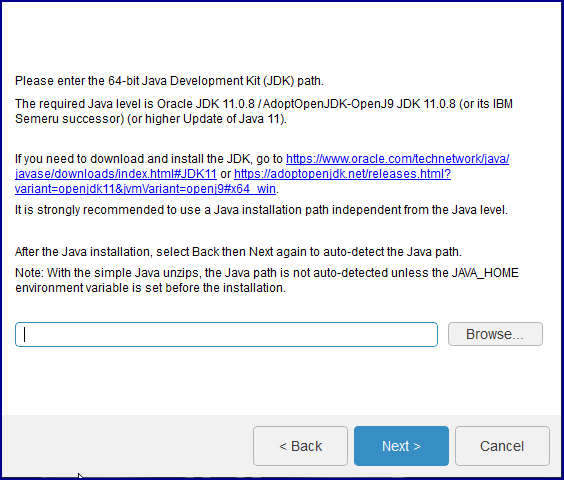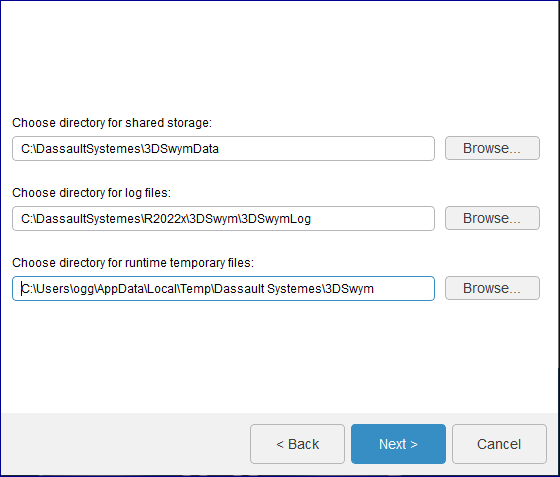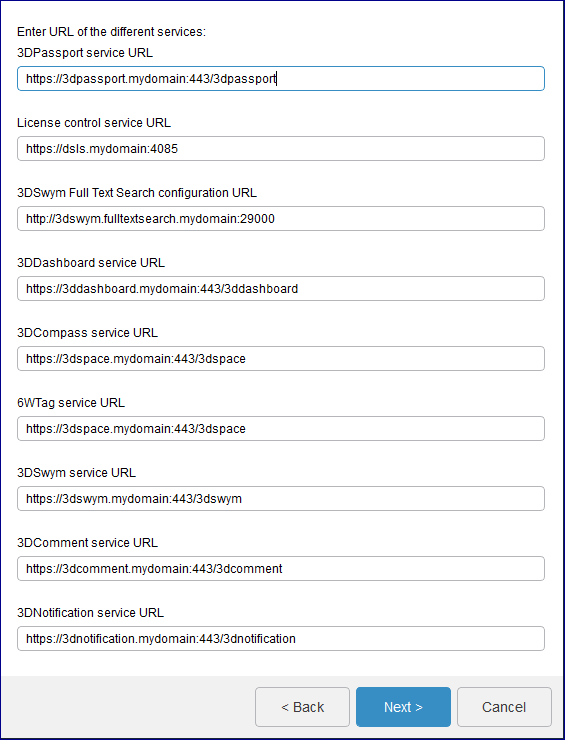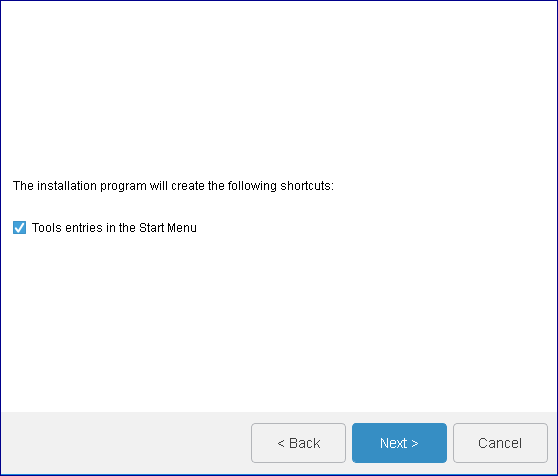Installing 3DSwym Video Converter | ||
| ||
- Procure the media for your operating system, and prepare to install the software as explained in the DS Installer Guide.
The name of the installation media is:
3DSwym-V6R2022x.Windows64.zipon Windows3DSwym-V6R2022x.Linux64.tar.gzon Linux
- Untar/unzip the media to create the following directory:
3DSwym.Windows64on Windows3DSwym.Linux64on Linux.
-
Change to the distribution directory.
The directory is:
- 3DSwym.Windows64/1 on Windows
- 3DSwym.Linux64/1 on Linux
then start the installation as follows:
- Windows: double-click setup.exe
- Linux: ./StartGUI.sh for the GUI, or ./StartTUI.sh
The installation procedure then starts:
 Note: The dialog boxes are the same on both Windows and Linux.
Note: The dialog boxes are the same on both Windows and Linux.Click Next.
-
Specify the installation directory.

The default values are:
C:\DassaultSystemes\R2022x\3DSwymon Windows/usr/DassaultSystemes/R2022x/3DSwymon Linux.
Note: The installation path cannot contain any space characters.If you accept the default destination folder, click Next, or click Browse... and select the desired destination folder. The folder you choose must be empty. You can also specify a new folder.
Click Next.
- In the list, select
3DSwym
Video Converter
in the list and unselect the others.

Click Next.
- Specify if you want to install embedded Java.

A JDK is required to install the service.
Java is used by:
- the installation program
- the 3DSwym Foundation : TomEE+ (for 3DSwym Content, Widget Platform and Rich Media Server web applications)
- the 3DSwym Video Converter : the external converter daemon.
The This install is for Testing or Demonstration purposes only (it uses an embedded JDK) check box is not selected by default.
If you select this check box, the embedded Server JDK will be installed in:
C:\DassaultSystemes\R2022x\3DSwym\win_b64\code\serverjreon Windows- /usr/DassaultSystemes/R2022x/3DSwym/linux_a64/code/serverjre on Linux.
Choosing embedded Java automatically implies also choosing embedded TomEE+.
Click Next.
-
If you did not check the This install is for Testing or Demonstration
purposes only (it uses an embedded JDK) check box, you must specify the Java
Home path.

This is the location of your Java Development Kit (JDK).
On Windows, the Java location will be automatically detected.
If you use a local Certificate Authority, register your certificates in this Java store using the
keytoolutility.Click Next.
- Specify the paths.

- the shared directory name to be used for storing data; the default is:
C:\DassaultSystemes\3DSwymDataon Windows and/share/DassaultSystemes/3DSwymDataon Linux. This folder must already exist.We recommend that you use a mounted path for the shared directory. This method is required when each 3DSwym component is installed on a different machine. This is useful when large amounts of data need to be saved, and also facilitates management of a load balanced environment.
need to be saved, and also facilitates management of a load balanced environment.
- the log directory containing application logs; the default is:
C:\DassaultSystemes\R2022x\3DSwym\3DSwymLogon Windows and/var/log/DassaultSystemes/3DSwymon Linux - the temporary directory used for 3DSwym runtime files; the default is:
C:\Users\user\AppData\Local\Temp\Dassault Systemes\3DSwymon Windows and/tmp/DassaultSystemes/3DSwymon Linux
Click Next.
- the shared directory name to be used for storing data; the default is:
- Specify the previously configured, dedicated URL endpoints for the 3DEXPERIENCE platform services.Note: Do not use uppercase characters in the URLs (standard form specified in RFC3986).

Before you do so, check the following:
- the URLs must contain Fully Qualified Domain Names (FQDN)
- the URLs must start with
http(s)://(and not ftp or other); note that all URLs arehttps://except Full Text Search - 3DPassport, 3DDashboard, 3DSwym, 3DComment and 3DNotification must have a root URI if you install all the services on the same machine
- 3DCompass and 6WTags must have a root URI
- If you install all the services on the same machine, the ports must be different.
Sample URLs (if the services are installed on different machines) are:
- 3DPassport service URL: the default is:
https://3dpassport.mydomain:443/3dpassport -
3DSwym
Index
configuration URL: the default is:
http://3dswym.fulltextsearch.mydomain:29000 - 3DDashboard service URL: the default is:
https://3ddashboard.mydomain:443/3ddashboard - 3DCompass service URL: the default is:
https://3dspace.mydomain:443/3dspace - 6WTags service URL: the default is:
https://3dspace.mydomain:443/3dspace - 3DSwym service URL: the default is:
https://3dswym.mydomain:443/3dswym - 3DComment service URL: the default is:
https://3dcomment.mydomain:443/3dcomment - 3DNotification service URL: the default is:
https://3dnotification.mydomain:443/3dnotification
The license control service URL (default is:
https://dsls.mydomain:4085) will only appear if the DSLicSrv.txt file is not present in C:\ProgramData\DassaultSystemes\Licenses (Windows) or /var/DassaultSystemes/Licenses (Linux). The DSLicSrv.txt file will then be created in the correct location, and will contain, for example:dsls.mydomain:4085. The user performing the installation must have write access to the directory containing the file.Click Next.
- If you are using embedded Java, specify the certificate location.

This directory contains the certificates to import into the JVM used by TomEE+.
The default is:
C:\Windows\Temp\DassaultSystemeson Windows/tmp/DassaultSystemeson Linux.
If you leave the path empty, you can import the certificates manually later as a post-installation step. For more information see Installation and Setup: Install: 3DEXPERIENCE Platform: Reconfiguring the 3DEXPERIENCE Platform Installation.
Click Next.
- On Windows, specify if you want to create Tools entries in the Start menu.

Select Tools entries in Start Menu.
Click Next.
-
Review your installation choices, then click Install to
install the files.

The 3DEXPERIENCE R2022x 3DSwym ExternalConverterSvc service will be automatically started at the end of the installation.